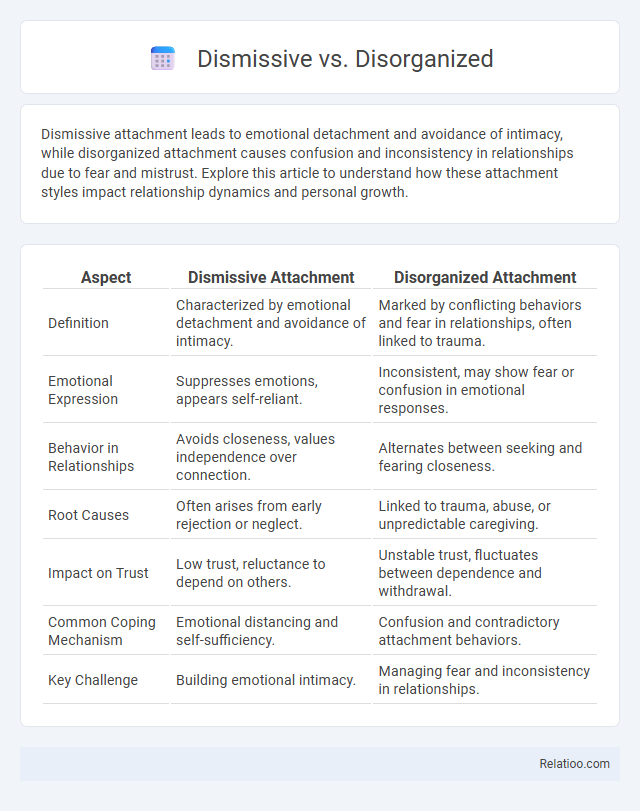Dismissive attachment leads to emotional detachment and avoidance of intimacy, while disorganized attachment causes confusion and inconsistency in relationships due to fear and mistrust. Explore this article to understand how these attachment styles impact relationship dynamics and personal growth.
Table of Comparison
| Aspect | Dismissive Attachment | Disorganized Attachment |
|---|---|---|
| Definition | Characterized by emotional detachment and avoidance of intimacy. | Marked by conflicting behaviors and fear in relationships, often linked to trauma. |
| Emotional Expression | Suppresses emotions, appears self-reliant. | Inconsistent, may show fear or confusion in emotional responses. |
| Behavior in Relationships | Avoids closeness, values independence over connection. | Alternates between seeking and fearing closeness. |
| Root Causes | Often arises from early rejection or neglect. | Linked to trauma, abuse, or unpredictable caregiving. |
| Impact on Trust | Low trust, reluctance to depend on others. | Unstable trust, fluctuates between dependence and withdrawal. |
| Common Coping Mechanism | Emotional distancing and self-sufficiency. | Confusion and contradictory attachment behaviors. |
| Key Challenge | Building emotional intimacy. | Managing fear and inconsistency in relationships. |
Understanding Attachment Styles: Dismissive vs Disorganized
Dismissive attachment is characterized by emotional detachment and a strong emphasis on independence, often leading individuals to avoid intimacy and suppress feelings. Disorganized attachment involves a contradictory behavior pattern, combining a desire for closeness with fear of rejection, resulting in unpredictable and confusing responses. Understanding the differences between dismissive and disorganized attachment styles helps in addressing emotional regulation challenges and improving relational dynamics.
Key Characteristics of Dismissive Attachment
Dismissive attachment is characterized by a strong desire for independence, emotional distance, and a tendency to suppress feelings or avoid intimacy. Individuals with dismissive attachment often downplay the importance of close relationships and struggle with vulnerability, prioritizing self-reliance over emotional connection. This contrasts with disorganized attachment, which involves confusion and fear in relationships, and anxious attachment, marked by clinginess and fear of abandonment.
Key Characteristics of Disorganized Attachment
Disorganized attachment is characterized by inconsistent, often contradictory behavior toward caregivers, mixing approach and avoidance responses that reflect an underlying fear or confusion. You may struggle with emotional regulation and experience difficulty forming trusting, secure relationships due to unresolved trauma or neglect in early life. This attachment style contrasts with dismissive attachment's emotional distance and avoidance, highlighting disorganized attachment's core unpredictability and fear-driven responses.
Root Causes and Developmental Origins
Dismissive and disorganized attachment styles both stem from early relational experiences but differ fundamentally in their root causes; dismissive attachment often originates from caregivers who were emotionally unavailable or rejecting, leading to your development of emotional self-reliance and avoidance of vulnerability. Disorganized attachment, by contrast, arises from inconsistent or frightening caregiving, causing confusion and fear that disrupt your ability to form coherent emotional responses. Understanding these developmental origins helps clarify why your attachment patterns impact your relationships and emotional regulation.
Emotional Responses and Coping Mechanisms
Dismissive attachment is marked by emotional detachment and avoidance of intimacy, leading You to suppress feelings and rely on self-sufficiency as a primary coping mechanism. Disorganized attachment involves conflicting emotional responses, including fear and confusion, often causing erratic behaviors and inconsistent coping strategies triggered by trauma or unresolved distress. Understanding these distinct emotional patterns highlights the importance of tailored approaches to managing relationships and emotional well-being.
Impact on Adult Relationships
Dismissive attachment often leads to emotional distance and avoidance in adult relationships, causing challenges in intimacy and trust. Disorganized attachment creates unpredictability and confusion in interactions, resulting in heightened anxiety and difficulty maintaining stable connections. Understanding your attachment style is crucial for improving communication and building healthier, more secure relationships.
Communication Patterns in Dismissive and Disorganized Individuals
Dismissive individuals tend to minimize emotional expression, often appearing aloof or indifferent in communication, which can create distance in relationships. Disorganized individuals exhibit inconsistent and unpredictable communication patterns, fluctuating between withdrawal and emotional volatility, making interactions confusing and challenging to navigate. Understanding these distinct communication styles can help you foster clearer, more empathetic connections with both dismissive and disorganized individuals.
Identifying Signs: Dismissive vs Disorganized Behaviors
Dismissive attachment behaviors often include emotional withdrawal, reluctance to depend on others, and a preference for self-reliance, while disorganized attachment is characterized by contradictory actions, fear of abandonment, and difficulty managing stress. Signs of dismissive individuals include avoiding intimacy and denying the need for close relationships, whereas disorganized individuals may display erratic responses, unpredictable mood swings, and confusion during interpersonal interactions. Recognizing these patterns helps in distinguishing dismissive detachment from the chaotic and fearful responses typical of disorganized attachment.
Healing and Therapeutic Approaches for Each Style
Healing from dismissive attachment involves building trust through consistent, empathetic therapy that focuses on increasing emotional awareness and vulnerability. Disorganized attachment requires trauma-informed approaches, such as EMDR or somatic experiencing, to address underlying fear and confusion while creating safety and predictability. Your therapeutic journey must be tailored to recognize the unique challenges of each style, fostering secure connections and emotional regulation.
Building Secure Attachments: Steps Toward Growth
Building secure attachments involves recognizing the distinctive patterns of dismissive and disorganized attachment styles, which each present unique challenges. For individuals with a dismissive attachment, fostering emotional awareness and trust through consistent, empathetic communication helps counteract avoidance behaviors. Those with disorganized attachment benefit from trauma-informed therapy and stable relational experiences that promote safety and integration, supporting gradual movement toward secure relational dynamics.

Infographic: Dismissive vs Disorganized
 relatioo.com
relatioo.com